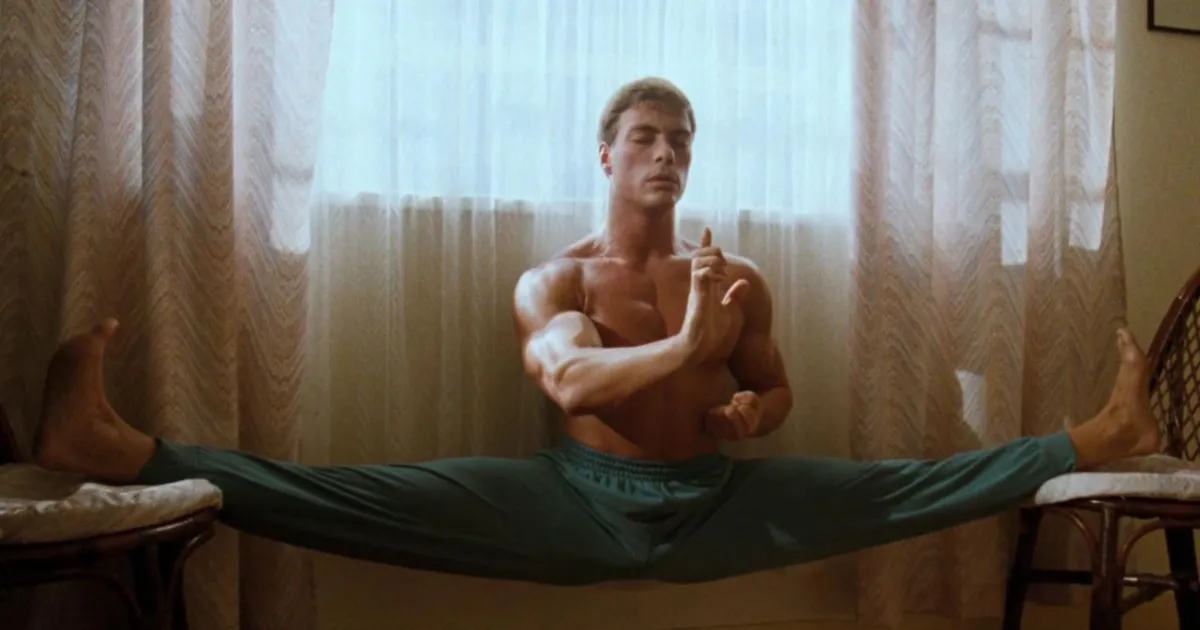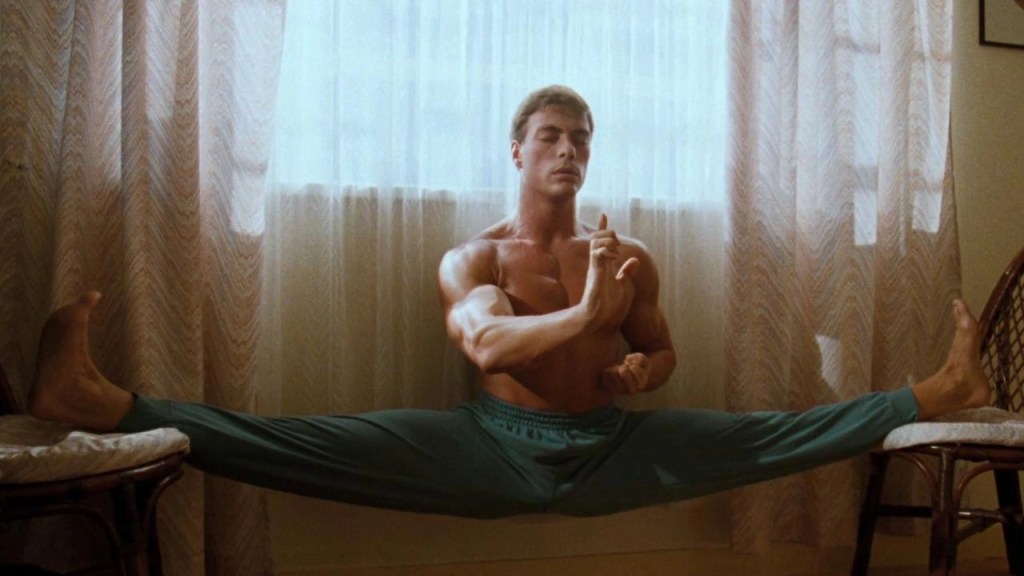Bloodsport Still Oozes Testosterone and Action 35 Years Later


Sometimes films are considered art because of the excellent acting, spectacular script writing, amazing cinematography, or cultural impact, and other times a movie is just simply Bloodsport.
What this particular icon of the silver screen lacks in a few of those previously stated categories, it makes up for in martial arts glory, pure ‘80s nostalgia, and direct injections of testosterone right into the viewer’s eyes. This is the film that made Jean-Claude Van Damme an overnight success – after it spent a couple of years on the shelf and had to be re-edited – and legend has it he obtained the role by showing up to a restaurant where Menahem Golan of Cannon Films, his soon-to-be boss, was exiting and simply kicked over the man’s head to show off his skills. What they created together became a staple in the movie libraries of many households, a foundation of the genre, and an inspirational piece for many.
The story in Bloodsport is an instant win because it’s about a fighting tournament. It’s easy to love a good movie with a martial arts bracket and getting to watch the hero engage with different opponents, climb to the top to face his rival, and win it all. Frank Dux (Van Damme) goes AWOL from the military to win a series of underground fights for the honor of his teacher, Senzo Tanaka (Roy Chiao), who’s on his deathbed. He’ll have to dodge the authorities through the streets of Hong Kong, make friends with the other combatants, and face down the cruel Chong Li (Bolo Yeung). It’s simple, clean, and has a positive ending.
The event in question is called the Kumite. It’s a good word. Say it a few times out loud, you’ll appreciate it. Kumite roughly translates to “free fighting,” which is perfect for a competition that’s supposed to be a no-holds-barred set of contests where people could be injured for life or even killed. The current champ, Chong Li, he did that to a guy once, “Yep, kicked the poor bastard right in the throat. Guy died right there on the platform. Chong Li stood there and watched him die.” A tournament like this is out of sight, out of mind, and it’s only held every five years, so it feels prestigious to those participating and witnessing it. That attracts a lot of different fighters sporting various styles from all around the world, a ‘best of the best’ kind of deal, but that’s another movie.
It isn’t all fighting, there’s a love interest in the form of Janice Kent (Leah Ayres), a journalist who is doing whatever it takes to get the skinny on the Kumite. Dux also bonds with Ray Jackson (Donald Gibb) and Victor Lin (Ken Siu), who acts as his fellow fighter from America and North American fighter liaison respectively. Jackson is like that good friend we all have, but are constantly apologizing to others for him. They make a great team and I’d have paid to see a buddy comedy about them just experiencing Hong Kong together after winning what Lin refers to as, ‘the biggest Kumite ever.’
The best relationship in the movie however is between Dux and Tanaka. Their history is stiff, stern, and isn’t loving like what the master wanted with his biological son, but with his offspring dead, Frank has filled that role. We see the intense training, respect, and growth between the two characters. It isn’t hard to get why Dux wants to prove himself to Tanaka. As someone whose father died when I was only a year old, I think this part of the movie registers a bit more. The two met when a young Dux and his friends were trying to steal a ceremonial sword from the Tanaka residence and it makes the ending mean more when he wins a similar sword for his Kumite victory, earning it the way his teacher wanted him to.
The actual martial arts in Bloodsport are solid, performed by a bunch of guys who knew what they were doing (with a couple of dancers mixed in), but there are many movies in the genre with better fully choreographed fights. In the end, this film excels less with the technical execution and more with its presentation and drama in the battles. It’s all about the journey, and each of these fights serves to exude style and reach the destination. There’s less art in the individual fights and more focus on Dux’s struggle and the passion behind that.
What makes Bloodsport even better is how it showcases numerous martial arts disciplines, mixing things up and giving these various characters a layer of personality that’s hard to match in movies like this, in most cases with the fighters barely speaking a word. This is something that is hard to do outside of martial arts films, adding that extra fingerprint, and somehow they excelled at making every challenger, even if we never saw them win, feel like they had their own skills and deserved to be in the tournament.
Some extra credit goes to the fact that these skirmishes were all done without stuntmen, meaning there was some legit contact going on in a few of these matches. Many praise the film for being able to sell the fighting at such a high level and pull people in, with most of the credit going to JCVD himself. His work to make the scenes look as best they could and his training in dance and ballet helped to make his moves look perfect for each shot. According to Van Damme, he also worked to save the fights in the editing process as well. These people matched well together, as two of them would go on to assist the actor with the film Kickboxer as well.
The soundtrack helped secure some glory for the film also. The score was created by Paul Hertzog and is an excellent accompaniment to many of the scenes where the songs by Stan Bush and Michael Bishop aren’t playing. There’s no reason not to get pumped when hearing “Fight to Survive,” just further proof that Bush was really killing it, even outside of Transformers. The overall sound design is solid for a film of this time with its reported budget (a number which is disputed in some places), but Bloodsport rocks with some quality surround sound.
This project gets some attention also for supposedly being loosely based on true events. Frank Dux is a real dude who claims to have led a pretty wild life, but there are those who think he’s a fraud. There are even stats at the end of the movie for Dux that sound amazing, unless you do some basic math and put a little thought behind them. There’s been a ton of back-and-forth concerning Dux’s legitimacy over the years, but either way, the story has made for a much better film that has created its own legacy.
Bloodsport certainly helped push some people toward the martial arts film genre and taking up the activity as well, in one form or another. I remember loving these movies and wanting to be like JCVD. I got involved with a Karate class, but my instructor ran away with his secretary when I was preparing to test for my yellow belt. Another life lesson I suppose.
JCVD and Bloodsport also provided a ton of inspiration for Mortal Kombat, another favorite of mine, and essentially, Johnny Cage only lives because of this movie. There are also some moments that have lived on as clips, references, memes, and signatures for the actor himself (all those splits). Most remember Dux being blinded at the end and using his training to succeed, it’s a great moment, or him going down for that stylish nut punch. The real Frank Dux says that was supposed to be to the bladder, but the angle made everyone think it was a dick shot (it’s cooler this way, Frank).
What will always stick in my head is the older man that exclaims, “Okay, U.S.A.” or my friend responding to everything I say he doesn’t like with various GIFs of Chong Li. It’s a quintessential ‘80s action movie, 90-plus minutes of muscle-bound dudes trying to tear each other apart with a little story, some kickass montages, and a great song to back it up. I tried to watch the sequels, but it is best not to mention them too much (especially part four). No, there will always be something special about whatever the original Bloodsport is – lightning in a bottle. Just the memory of me sitting on the floor watching it on TBS and being inspired, even if it was simple, not well-acted, or a lie, Bloodsport still means something to me and many others 35 years later.




